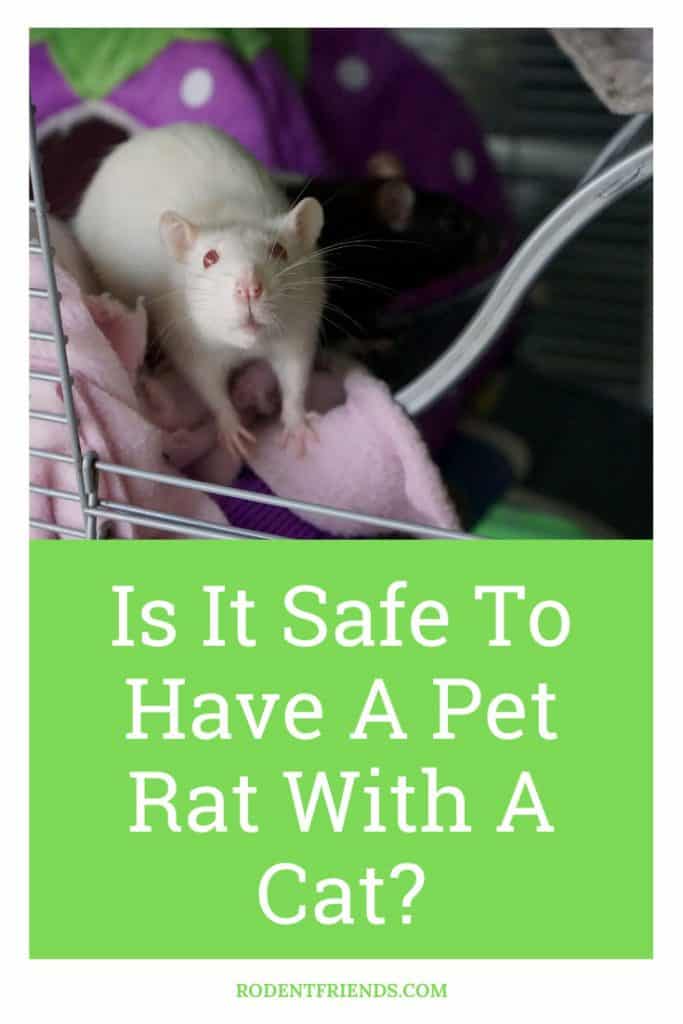If you already own a cat and want to bring some pet rats into your house, it’s understandable to have some worries. Is it safe to have a pet rat along with a cat or not? The same goes for the reverse situation. All over popular media, we see depictions of cats and rats being natural enemies!
Truth is they can get along very well! Pet rats are known to get along with other animals, especially cats.
Pet rats can get along safely with cats as long as there’s constant supervision on the owners’ part. You’ll also need to take special precautions such as acclimating your pet rats to your cat and keeping them in separate rooms.
Of course, there are some arrangements to make and it’s a long process. They’ll need to be introduced to each other slowly, so nothing bad happens and you should always be present.
Without further ado, let’s go over the steps to introduce your cat to your pet rats, safely!
How To Introduce Pet Rats To Cats
Pet rats get along very well with other animals, especially with cats and dogs! We’ve always seen on cartoons the rivalry between rats and cats, but the truth is they can very easily be lifelong companions!
Of course, this introduction needs to be slow at first. They’re different species and need to get used to each other. Even among the same species, both dogs and cats need to acclimate to the idea of having another companion.
This is fairly normal and it also depends on the animal’s personality! Some cats are very extroverted and will welcome another cat right away, other’s not so much.
The same goes for pet rats and the relationship between a cat and a rat.
But one thing you should know from the start is that pet rats are nervous creatures by nature. Anything new will cause them some stress, so it’s important to take things slowly. You might notice them overgrooming themselves, which is something I cover in my article about Why Your Pet Rat Is Grooming (right here).
So, if the pet rats are a new addition to your household, I highly recommend to let them first get used to their new home and environment.
They’ll already be nervous about this big change and for that reason, it’s important to leave introductions between them and other pets for later!

It’s also important for your rodent friends to first get acclimated and bonded with you, before introducing them to another animal. This way, when the time comes, they already feel safe both around you and their new home!
So for that reason, the first step is to just let your pet rat be for the first two weeks, trying to spend some time with them, but without forcing the contact. During this time, your cat shouldn’t be in the same room as the pet rats. If you have no other choice, then try to avoid contact between them.
It’s natural that the cat will feel curious, but it’s important to keep them apart so as not to cause stress to your rodent friends!
Now when it’s time to introduce your pet rats to your cats, do it always under your supervision! Never leave them out of your sight and be ready to intervene if necessary.
Even if your cat isn’t aggressive towards your pet rat, they can still very easily hurt your pet rat in a blink of an eye! The cat might not understand how fragile the other animal is and by trying to play with the rats, hurt them by accident.
Take things slowly, by first letting them sniff each other through the cage bars, once they feel more comfortable you can’t start letting the pet rats leaving the cage and for them to get closer to the cat.
Remember that this process can be very slow and never force the cat or the pet rats to contact each other! Let them choose their pace.
How To Cat Proof A Pet Rat Cage
Especially if you’re wondering about having your pet rat free roam, you should cat proof your pet rat cage! If you’re interested in free roaming (which I highly recommend) you can check my Safety Guide article on free roaming here!
A big and sturdy cage is a must. Not only for the pet rats to live comfortably, but so the cat can’t reach it as easily. I always recommend the Prevue Hendryx cage (link to Amazon).
It’s usually made towards ferrets, but it’s perfect for 2 or more pet rats. It’s really big, sturdy and different levels for your rodent friends to live in!
If you notice, this cage comes with some wheels. I always recommend for you to not add these to the cage since it’s supposed to stay in the same place. This way the cage won’t move around the room by accident.
Not only that, but if the cat decides to try to jump into the cage, or tries to reach it, by having the wheels, there’s a bigger chance of the cage falling. We don’t want that and we want our pet rats and cat safe!
Now there is however a disadvantage to this cage: the space between the bars is too big. This needs to be fixed, both so that the pet rats can’t escape their cage (which they’ll do given the opportunity) and so the cat can’t put its paws through it.
So I always recommend buying some Hardware Cloth, on Amazon, to reinforce the cage. Just assemble it around the cage, fix it and now nothing can go through the bars!
These are the two most important aspects of cat proofing a cage: being hard to reach and bars close together so the cat can’t fit its paws in it.
Again, the cat might not even want to attack the pet rats, but they’re also curious by nature and will feel the need to reach and touch them.
They might hurt your rodent friends by accident, and your pet rats will also get really stressed.
Stress is never good for them and can actually kill them. So having a good and safe environment it the most important!
And remember, never let your cat be in the same room as your pet rats without your supervision! They should never be left alone together. If for some reason, you need to intervene, accidents are bound to happen if you can’t.
Have Your Pet Rats And Cats In Separate Rooms
Even after some time of introducing them to each other, your pet rats and the cat might not get along with each other.
It just happens. Animals have their own personality and they might not like companions from other species. And that’s alright!
This, of course, doesn’t mean you have to get rid of one of the pets! Just let them live in different rooms. Choose a room where your pet rats cage will be and don’t let your cat enter it.
Both the cat and the pet rats can live in harmony and you never have to worry about what could happen if you got distracted for one second.

You might still allow your cat to enter the room if you go in there. It all depends on their reactions and if you feel that, as long as you’re present, things are controlled.
However, if they never got used to each other and you know they won’t get along, I don’t recommend letting your pet rats leave their cage if the cat is present.
Your pet rats should have a playground outside of their cage, so they can freely play. Set a time for fun and plays, sit and play with them but don’t let the cat in.
If the pet rats get scared, they’ll have more space to escape and it will be harder to find them. Not only that, but that reaction might trigger your cat to chase them!
In short, it would be chaos and we want to avoid that! So set a playtime for your pet rats, where your cat is forbidden. To make it up for the cat, set another playtime with them as well!
Furthermore, if you do allow your cat to enter the room, always be vocal when they’re doing something wrong! If they try to reach the cage tell them “Stop”, “No!” or even “Don’t”.
It’s important for your cat to understand vocal orders and to obey them. As long as they listen to you, you won’t have to worry as much!
At some point, they’ll learn to leave the cage alone and won’t even show interest in the pet rats or the cage.
Teaching Your Cat To Get Along With Rats
Depending on the age of the cat, it gets easier or harder to introduce it to pet rats. For example, older cats are not as energetic and won’t even show as much interest in new things.
For that reason, it can be easier for an older cat to get along with pet rats. This doesn’t mean that it’s impossible to do the same with younger cats.
They’re much more energetic and will be very, very curious about the new tenants, but with your help and supervision, they can get along fantastically!
It might just take a bit longer and require some more patience from you.
So as I mentioned above, the first step to start introductions is by having the cat meet the pet rats through the cage. You can even try and hold your cat, get it closer to the cage and let them sniff each other.
Don’t allow more than a sniff. Again this will be a stressful event for the pet rats if there’s too much movement and they feel threatened. So don’t let your cat reach them with your paws nor make abrupt movements.
Repeat this exercise every day for some time. Once you feel they’re getting used to each other, let your cat approach the cage. If it tries to lift up a paw towards it, be vocal and tell them to stop.
It is very important that they learn not to play with the cage!
And in this phase, even if you let your cat go to the cage to sniff the pet rats, always be close to them! That way, if something wrong happens you’re close by to stop it from happening!
Let them acclimate to each other and only when you notice that both the pet rats and the cat are comfortable with each other can you try and let the pet rats leave the cage.
Always be on the lookout if your pet rat squeaks! Maybe they weren’t physically hurt, but they could be very scared. I’ve talked about several reasons that pet rats squeak, that you should check out there.
This should be done in a safe and small perimeter. You can make a barrier around the cage, where you, the cat and the pet rats fit. And always give your pet rats the means to get back into their cage if they so desire!
It is also very important for your cat to be already trained. It doesn’t need to be anything to complicated. They should understand a no and a yes, so it’s easier to control the cat if they do something wrong.
Just give it time and take things slowly. Don’t rush it and don’t force them to interact with each other if they’re not interested in it or if the cat or pet rats are too scared.
You’ll see that with time and patience, they’ll be best friends for a long time!
Back to the Blog





